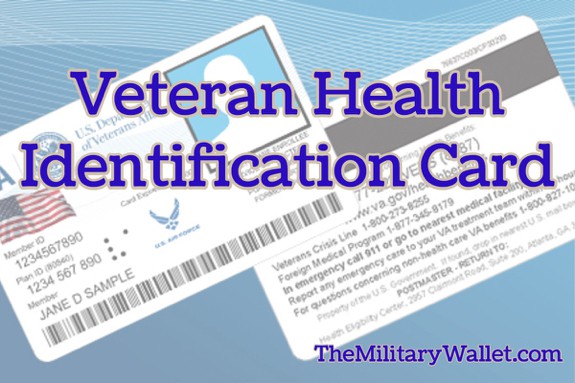Many military veterans are unaware that the VA offers two different forms of veterans ID cards. The first version is the Veteran Health Identification Card (VHIC), formerly known as the Veterans Identification Card (VIC). This card is available to military veterans who are eligible for VA health care benefits.
The other veterans ID card is what is now known as the Veterans Identification Card (VIC). The VIC is the result of the Veterans Identification Card Act which Congress passed in 2015. However, the VA didn’t begin issuing these veterans ID Cards until November 2017. The VIC is available to all veterans with an honorable discharge. It is only to be used as a form to show proof of military service. However, it is not valid for any form of benefits.
This is in contrast to the Veteran Health Identification Card which is used as ID when scheduling and checking into appointments at the VA, as well as base access for commissary and post exchange privileges (this is due to the 2020 law that allowed disabled veterans base access for Commissary, Exchange, and MWR facilities).
Veterans Health Identification Card Overview
In this article, we will discuss the Veterans Health Identification Card, which is designed to serve as an Identification card for the VA health care system. The official purpose is to check in to appointments for receiving VA health care benefits. However, many veterans also use this card to prove their military service. This can be helpful if you do not have a military ID card, the new VIC, or your state doesn’t offer a veterans designation on their driver’s licenses (most states now offer this).
Also, starting in 2020, the VHIC can be used by qualified veterans to access miliary installations and shop at the base Commissary, Exchanges, and certain MWR retail activities. Veterans using the VHIC for Commissary, Exchange, and MWR benefits must have a designation on the VHIC stating, Service Connected, Purple Heart, or Former POW.
The good news is that all military veterans are potentially eligible to receive one of these VA Health ID cards. This card is the preferred form of ID when receiving VA health care, and can be a great way to prove your military service or help secure military discounts from companies that offer discounts to veterans.
Let’s take a look at the qualifications to receive a VA issued ID Card:
Veterans Health Identification Card Eligibility
The Veterans Health Identification Card (VHIC) is only available to military veterans who are eligible to receive VA health care benefits. There are many misconceptions regarding VA health care eligibility, and there are thousands of veterans who are unaware they are eligible for VA medical benefits.
You don’t need to have a service-connected disability to be eligible to receive VA health care benefits. Eligibility is based on active duty service in the Air Force, Army, Coast Guard, Marines, Navy, or Merchant Marines (in WWII), who have an “other than dishonorable discharge.” Former members of the Reserves or National Guard may be eligible if they were activated under Federal Executive Orders (this generally excludes activation for training purposes).
Other eligibility factors include active duty service dates, deployments you may have served on, or other criteria, such as being discharged for medical reasons, serving in a war zone (Vietnam War veterans and Persian Gulf veterans who served in theater during certain dates are eligible for VA health care benefits), Former POWs, Purple Heart recipients, and veterans who meet certain household income requirements may be eligible for VA medical care benefits.
Here is more information for determining VA health care eligibility. You can also contact the VA to determine health care eligibility or use this eligibility questionnaire.
Apply for VA Health Care Benefits First
You must be enrolled in the VA health care system in order to receive a VHIC. To do this, you must establish eligibility and fill out Form 10-10EZ or Form 10-10EZR (these are also the same forms used to update your personal information).
You can fill out this form online, by phone (Call 1-877-222-8387, Mon-Fri, 8:00 am – 8:00 pm EST), by mail, or in person at any VA clinic or medical facility. Here is the VA Directory to find a location near you.
Where to Get Help Applying for VA Healthcare Benefits
You can visit your local VA medical care facility for assistance with your application. You can also visit your county Office of Veterans Affairs. These offices are run by the state or your local county, and are not directly affiliated with the VA. However, they have trained benefits counselors who can assist you free of charge.
Finally, you can contact a Veterans Service Organization such as the DAV, AMVETS, American Legion, VFW, and similar organizations. These organizations offer free benefits claims assistance, and often have local offices. If not, you can often contact someone through one of these sites. Here is a list of similar organizations.
How to Apply for a VA Health ID Card
After you have enrolled in the VA health care system, you can visit your local VA clinic or medical facility to obtain an ID card. You will need to bring a primary form of identification, such as a state-issued driver’s licenses or ID card, a passport, or a similar form of ID with photo identification.
You will then have your information entered into the VA system and have your photo taken. The card will then be mailed to you within 7-10 business days. Be sure to verify all the information is correct on the VA ID Card when you receive it.
What You Need to Know About the VIC Card
The Veterans Health Identification Card only contains your name, branch of service, photo, and any special benefits designations, such as a mark for a service-connected disability, POW Status, or Purple Heart recipient.
The cards no longer contain printed Social Security Numbers, date of birth, or other confidential personal information on the front of the card. In fact, the newer cards are more secure and do not contain any personally identifiable information on the magnetic stripe or barcode.
Each card also includes a Unique Member Identifier — Department of Defense assigns an electronic data interchange personal identifier (EDIPI) that allows VA to retrieve the Veteran’s health record.
If your Veterans Identification Card is lost or stolen, you should contact the medical facility that issued your card. Photos are maintained on file, so you won’t need to have another photo taken. You will have to verify your personal information to prove your ID.
The VA ID Card is not an insurance card.
The only authorized use of the Veterans Identification Card is for verifying ID at VA facilities. It is not an insurance card and cannot be used to pay for medical care at non-VA medical facilities. Though not an official use, many veterans use these cards to prove military service.
Should You Get a VHIC, Even if You Don’t Use the VA for Healthcare?
I think it’s a great idea to apply for the Veterans Health ID Card if you qualify, even if you don’t plan on using the VA healthcare system for your primary source of medical care.
The first reason is that it gets you into the VA healthcare system. That way you can use the healthcare benefits if your status changes and you need to do so.
The second reason is that the DoD will begin allowing veterans with a service-connected disability rating to gain base access and use amenities such as the Commissary, Exchanges, and certain MWR retail activities. However, you must have a VHIC with a designation of Service Connected, Former POW, or Purple Heart, in order to use these benefits.
This program starts on January 1, 2020.
Photo source: VA




Comments:
About the comments on this site:
These responses are not provided or commissioned by the bank advertiser. Responses have not been reviewed, approved or otherwise endorsed by the bank advertiser. It is not the bank advertiser’s responsibility to ensure all posts and/or questions are answered.
Michael Bradley Fox says
Hi, I am trying to Apply for a V.H.I.C. card I live overseas in Mannheim, Germany I was told I can Apply on-line but haveing trouble , I just got my ID.me Today and they said I can Apply but I have no luck,
Thank You hope to hear from you,
douglas hawn says
been in system 5 years, have no card, would like vhic card. got photo vet hosp never got id mail